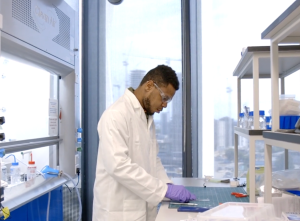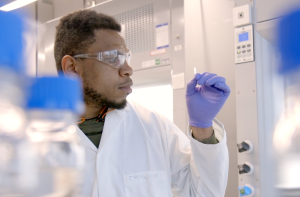Written by Chukwudike Ukeje, a taught postgraduate student in the Department of Materials.
Chukwudike recently completed a year studying for an MSc in Advanced Materials Science and Engineering, which included a research project at the White City campus. In this post, he shares more about his research project, using our new facilities and solving hypotheses in the lab. In this post, he shares more about his research project, using our new facilities and solving hypotheses in the lab.
My MSc research was in the functional materials research area, where I carried out a project on the topic “Development of Barium Calcium Zirconium Titanite (BCZT) thin films for applications in capacitive thermoelectric converters”. I choose to work in this area because of my interest in thin film development for energy applications. As the project title suggests, the main goal of my research was to fabricate a thin film of Barium Calcium Zirconium Titanite – a functional oxide material with superb dielectric properties and test its suitability to function as a thin dielectric layer in a capacitive thermoelectric conversion device. My MSc project was a part of a more extensive PhD research looking to develop a capacitive thermoelectric device capable of converting low-grade waste heat from devices such as our mobile phones and laptops into electricity.

I conducted my MSc research at the Thin film Device Materials Platform at the White City Campus. For my project, I joined Dr Peter Petrov’s research group, and I was able to use various state-of-the-art facilities. This includes the E-beam deposition, Pulsed Laser deposition, photolithography, and ion milling systems for thin film fabrication and patterning. I also used the CryoProbe station for electrical characterisation and the X-ray diffraction and photoelectron spectroscopy techniques for structural and chemical characterisation.
I have learned quite a lot during this time. My research allowed me to gain a practical appreciation of the theoretical knowledge I acquired while taking my taught modules in the last two terms. I gained on-hand training on various material characterisation processes and thin film deposition techniques. I also learned presentation skills as we had to create a presentation of our research progress for the group every week. These weekly presentations helped me build confidence in presenting and sharing my research work with the public.
Overall, I had many memorable highlights during my research placement. However, two, in particular, stand out. One is my first visit to the clean room facility. Working in the clean room was a unique experience, and I enjoyed learning about the specific attire we have to wear (a full-body suit from head to toe!). My second highlight was the day a PhD student and I confirmed a certain hypothesis while carrying out some measurements. We had made some films following a specific recipe but later found they weren’t responding to temperature changes as we had expected. As a result, we made a few deductions and modified our fabrication recipe. On carrying out the measurements again, boom! When this happened, the smiles on our faces were contagious enough that we took a selfie to save the memory of the day we made our first temperature-responsive film.


